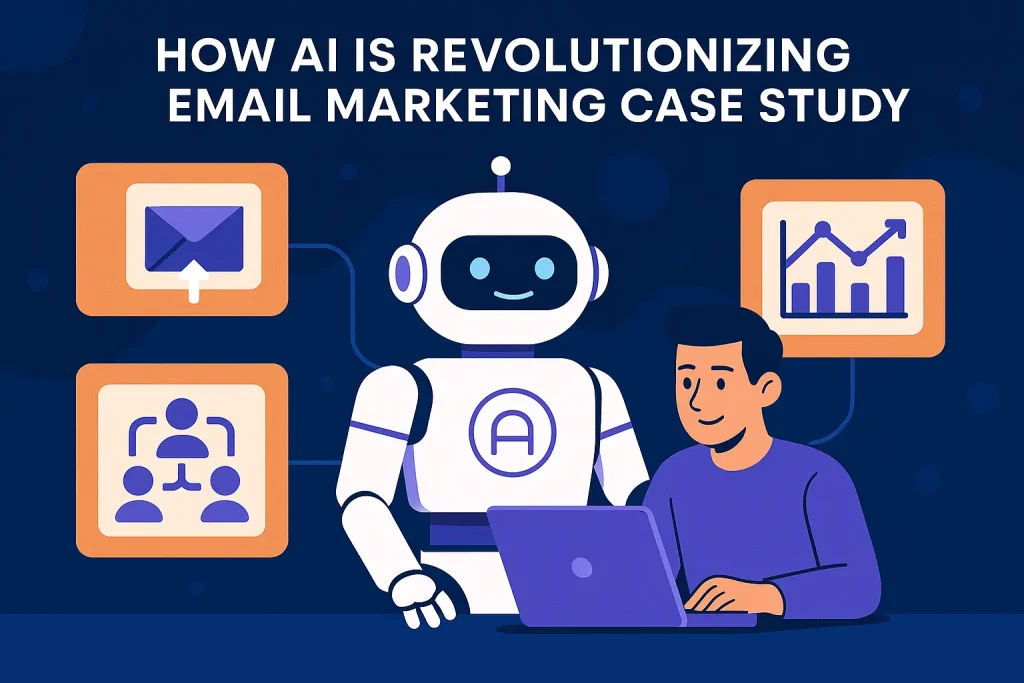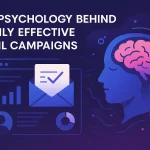The landscape of email marketing is undergoing a significant transformation, driven by the integration of artificial intelligence. This technological advancement is not only enhancing the efficiency of email campaigns but also personalizing customer experiences like never before.

By leveraging email automation and AI-driven insights, businesses can now tailor their marketing strategies to meet the specific needs of their audience. This case study explores the challenges, solutions, and results of implementing AI in email marketing campaigns, providing valuable insights for marketers looking to stay ahead in the competitive landscape.
Table of Contents
The Evolution of Email Marketing in the Digital Age
The landscape of email marketing has undergone significant transformations since its inception. As technology advances and consumer behaviors evolve, the strategies and tools used in email marketing have had to adapt to remain effective.

Traditional Email Marketing Approaches and Their Limitations
Traditional email marketing often relied on broad, generic campaigns sent to large lists with little personalization. This approach had significant limitations, including low engagement rates and a lack of relevance to individual recipients. The one-size-fits-all strategy failed to account for the diverse preferences and behaviors of customers.
For instance, a study highlighted the inefficiency of traditional methods, showing that personalized emails have higher open and click-through rates compared to non-personalized ones. The table below illustrates the difference:
| Email Type | Open Rate | Click-Through Rate |
|---|---|---|
| Personalized Emails | 25% | 10% |
| Non-Personalized Emails | 15% | 5% |
The Need for Innovation in a Crowded Inbox
The modern email inbox is crowded, with consumers receiving numerous emails daily. This environment necessitates innovation in email marketing to stand out. Marketing technology has played a crucial role in this innovation, enabling more sophisticated data analysis and the application of machine learning to improve campaign effectiveness.
“The future of email marketing lies in its ability to personalize and adapt to the consumer’s journey, making each interaction more relevant and engaging.”
By leveraging these technologies, businesses can create more targeted and engaging campaigns, addressing the challenge of the crowded inbox and enhancing the overall impact of their email marketing efforts.
Understanding the Power of AI in Marketing Communications
Artificial intelligence is transforming the marketing landscape by enabling more personalized and efficient communication strategies. As businesses strive to stay ahead in a competitive digital environment, understanding and leveraging AI is becoming increasingly crucial.
Defining Artificial Intelligence in the Marketing Context
Artificial intelligence in marketing refers to the use of AI technologies to automate and optimize marketing processes. This includes analyzing customer data, personalizing content, and predicting consumer behavior.
AI technologies are being used to enhance customer experiences, improve engagement, and ultimately drive sales. By analyzing vast amounts of data, AI can help marketers understand their audience better and tailor their strategies accordingly.
Key AI Technologies Transforming Digital Communication
Several key AI technologies are transforming digital communication in marketing. These include machine learning algorithms, natural language processing, and predictive analytics.
Machine Learning Algorithms
Machine learning algorithms enable systems to learn from data and improve their performance over time. In marketing, these algorithms are used for tasks such as customer segmentation and personalization.
Natural Language Processing
Natural Language Processing (NLP) allows computers to understand and generate human language. In marketing, NLP is used for chatbots, sentiment analysis, and content generation.
Predictive Analytics
Predictive analytics uses historical data and statistical models to forecast future events. In marketing, it’s used to predict customer behavior and identify new opportunities.
| Technology | Primary Use in Marketing | Benefits |
|---|---|---|
| Machine Learning Algorithms | Customer Segmentation, Personalization | Improved targeting, Enhanced customer experience |
| Natural Language Processing | Chatbots, Sentiment Analysis, Content Generation | Automated customer service, Insight into customer sentiment |
| Predictive Analytics | Predicting Customer Behavior | Proactive marketing strategies, Increased sales |

Case Study Overview: Company Background and Challenges
At the heart of our case study is a company that has harnessed the power of AI to transform its approach to email marketing. This company, a leader in its industry, faced significant challenges in maintaining customer engagement through traditional email marketing methods.
Company Profile and Market Position
The company in question is a well-established player in the e-commerce sector, known for its innovative products and customer-centric approach. With a strong online presence and a large customer base, it has been at the forefront of adopting new marketing technologies.
Key statistics about the company include:
- A customer base of over a million subscribers
- A product portfolio that is regularly updated with new and innovative items
- A strong commitment to using technology to enhance customer experience
Email Marketing Pain Points and Objectives
Despite its strong market position, the company faced several challenges with its email marketing efforts. These challenges can be summarized into three main areas:
Declining Engagement Metrics
The company observed a steady decline in open rates and click-through rates over several months. This decline indicated a growing disengagement among its customer base, necessitating a change in strategy.
Resource-Intensive Manual Processes
The process of creating, sending, and analyzing email campaigns was highly manual, consuming a significant amount of resources. This not only increased operational costs but also limited the company’s ability to scale its email marketing efforts.
Competitive Pressure
The e-commerce sector is highly competitive, with numerous players vying for customer attention. The company needed to differentiate its email marketing campaigns to stand out in a crowded inbox.
By addressing these challenges through the adoption of AI technologies, the company aimed to improve its email marketing metrics, reduce operational costs, and enhance customer engagement through more personalized emails and efficient email automation processes.
How AI is Changing the Game in Email Marketing
AI technologies are changing the email marketing landscape by enabling more precise audience targeting and content optimization. This transformation is crucial in today’s digital age, where consumers are inundated with emails and businesses must compete for attention.
From Manual Segmentation to AI-Powered Audience Targeting
Traditional email marketing relied heavily on manual segmentation, a process that was not only time-consuming but also often resulted in less than optimal targeting. AI-powered audience targeting has revolutionized this by analyzing vast amounts of customer data to identify patterns and preferences that were previously unnoticed.
This advanced targeting capability allows marketers to create highly personalized campaigns that resonate with their audience on a much deeper level. By leveraging machine learning algorithms, businesses can now segment their email lists more accurately and dynamically, ensuring that the right message reaches the right person at the right time.
Predictive Analytics for Content Optimization
Predictive analytics is another area where AI is making a significant impact in email marketing. By analyzing historical data and customer behavior, predictive models can forecast future actions, such as opens, clicks, and conversions. This insight enables marketers to optimize their content in real-time, improving engagement and ultimately, the ROI of their campaigns.
For instance, AI can help determine the most effective subject lines, email content, and even the optimal send times for different segments of an audience. This level of content optimization was previously unimaginable with traditional email marketing methods, marking a significant leap forward in how businesses interact with their customers.
The AI Solution: Technology Stack and Implementation
To revolutionize email marketing, businesses must adopt a comprehensive AI solution. This involves not only selecting the right marketing technology but also ensuring seamless integration with existing infrastructure and a well-planned implementation timeline.
AI Tools and Platforms Selected
The company chose a cutting-edge AI platform that specializes in email automation and predictive analytics. This platform was selected for its ability to handle large datasets and provide actionable insights through AI algorithms. The tools were chosen based on their compatibility with the company’s existing marketing technology stack.
The selected AI platform offered advanced features such as dynamic content generation, personalized send times, and frequency optimization. These features were crucial in enhancing the company’s email marketing capabilities.
Integration with Existing Marketing Infrastructure
Integration was a critical step in the implementation process. The AI platform was integrated with the company’s existing CRM and email service provider (ESP) to ensure a cohesive and efficient workflow. This integration enabled the company to leverage customer data and create highly targeted email campaigns.
The integration process involved API connections and data mapping to ensure that customer data was accurately transferred between systems. This step was crucial for maintaining data integrity and ensuring that the AI algorithms had access to the necessary information.
Implementation Timeline and Process
The implementation was carried out in three phases: planning, pilot testing, and full deployment.
Planning Phase
During the planning phase, the team defined the project scope, identified key stakeholders, and established a timeline. This phase was critical in setting clear objectives and ensuring that all team members were aligned.
Pilot Testing
The pilot testing phase involved a small-scale rollout of the AI solution to a subset of the customer base. This allowed the team to test the integration, identify potential issues, and make necessary adjustments before full deployment.
Full Deployment
Following the successful pilot test, the AI solution was fully deployed across the entire customer base. The deployment was monitored closely to ensure a smooth transition and to address any issues promptly.
Data Collection and Analysis Methodology
To harness the power of AI in email marketing, it’s essential to have a robust data collection and analysis framework in place. This framework not only enhances the understanding of customer behavior but also informs the development of targeted marketing strategies.
Customer Data Sources and Management
Effective customer data management begins with identifying and integrating diverse data sources. These include:
- Customer interactions with email campaigns
- Website browsing history
- Purchase history
- Social media engagement
By consolidating these data points, businesses can develop a comprehensive view of their customers’ preferences and behaviors. The table below illustrates the types of customer data and their sources.
| Data Type | Source |
|---|---|
| Email Engagement Metrics | Email Campaign Analytics |
| Browsing History | Website Cookies, Tracking Pixels |
| Purchase History | CRM Systems, Sales Data |
AI Algorithms for Behavioral Pattern Recognition
AI algorithms play a pivotal role in analyzing customer data to identify behavioral patterns. Techniques such as machine learning and predictive analytics enable marketers to anticipate customer needs and tailor their campaigns accordingly.
For instance, clustering algorithms can segment customers based on their purchase history and browsing behavior, allowing for highly targeted marketing efforts. Moreover, AI-driven predictive models can forecast future customer actions, enabling proactive campaign adjustments.
By leveraging these advanced data analysis techniques, businesses can significantly enhance the efficacy of their email marketing campaigns, leading to improved customer engagement and conversion rates.
AI-Driven Personalization Strategies Implemented
The use of AI in email marketing has opened up new avenues for personalization, making it possible to tailor every aspect of an email campaign to the individual user. This level of customization was previously unimaginable due to the limitations of traditional marketing methods.
Dynamic Content Generation Based on User Behavior
One of the key strategies implemented was dynamic content generation. By analyzing user behavior, AI algorithms can create content that is highly relevant to the individual recipient. This approach ensures that the emails are more engaging and have a higher likelihood of conversion.
Email automation plays a crucial role in this process, enabling marketers to send the right content at the right time without manual intervention. By leveraging behavioral patterns, businesses can create personalized emails that resonate with their audience.
Personalized Send Times and Frequency Optimization
Another critical aspect of AI-driven personalization is optimizing send times and frequency. By analyzing user behavior and engagement patterns, AI can determine the best time to send emails to maximize open rates and engagement.
Time Zone Optimization
AI algorithms can adjust send times based on the recipient’s time zone, ensuring that emails are delivered at an optimal time. This approach helps in increasing the chances of the email being opened and read.
Behavioral Timing Patterns
Understanding behavioral timing patterns allows marketers to send emails when their audience is most likely to engage. This could be based on past interactions, purchase history, or other behavioral data.
Engagement-Based Frequency Control
AI also enables engagement-based frequency control, where the frequency of emails is adjusted based on how the recipient engages with previous emails. This ensures that subscribers are not overwhelmed with emails, reducing the risk of unsubscribes.
Subject Line Optimization Through Machine Learning
In the quest for higher email open rates, subject line optimization through machine learning has emerged as a game-changer. Crafting subject lines that capture the attention of recipients has always been a challenge in email marketing. With the integration of machine learning algorithms, marketers can now analyze vast amounts of data to predict which subject lines are most likely to succeed.
Machine learning enhances the process by identifying patterns in customer behavior and preferences, allowing for more personalized and effective subject lines. This not only improves open rates but also contributes to a better overall customer experience.
A/B Testing Enhanced by AI
A/B testing is a traditional method used to compare the performance of different subject lines. However, when enhanced by AI, this process becomes significantly more powerful. AI algorithms can analyze the results of A/B tests at scale, identifying subtle patterns that may not be apparent to human analysts.
For instance, AI can determine not just which subject line performs better, but also why it performs better, based on factors such as wording, length, and the use of specific keywords or emojis. This insight allows marketers to refine their subject line strategies continually.
“The future of email marketing lies in its ability to personalize and adapt to customer interactions in real-time, and AI-driven A/B testing is a crucial step in this direction.”
— Email Marketing Expert
Natural Language Processing for Compelling Headlines
Natural Language Processing (NLP) is a subset of AI that focuses on the interaction between computers and human language. In the context of subject line optimization, NLP can be used to craft headlines that are not only relevant but also compelling to the recipient.
NLP algorithms can analyze the tone, syntax, and semantics of language to predict how different subject lines will be perceived by the target audience. This enables marketers to create subject lines that are more likely to resonate with their audience.
The table below illustrates the impact of NLP on subject line performance:
| Subject Line Characteristic | Without NLP | With NLP |
|---|---|---|
| Open Rate | 15% | 25% |
| Click-Through Rate | 2% | 5% |
| Conversion Rate | 1% | 3% |
Campaign Automation and Workflow Enhancements
As AI continues to evolve, its impact on campaign automation and workflow enhancements in email marketing is becoming increasingly significant. The ability to automate complex email campaigns has transformed how businesses interact with their customers, making the process more efficient and personalized.
Trigger-Based Email Sequences
Trigger-based email sequences are a powerful tool in email automation, allowing businesses to send targeted emails based on specific customer actions or behaviors. This approach ensures that customers receive relevant information at the right time, enhancing their overall experience.
For instance, a welcome email can be triggered when a customer subscribes to a newsletter, followed by a series of educational emails about the company’s products or services.
Automated Customer Journey Mapping
Automated customer journey mapping is another critical aspect of campaign automation. It involves using AI to map out the customer’s journey, identifying key touchpoints and opportunities for engagement.
Onboarding Sequence Optimization
Optimizing the onboarding sequence is crucial for retaining new customers. AI-driven automation can help personalize the onboarding process, ensuring that new customers receive the most relevant information.
Re-engagement Campaign Automation
Re-engagement campaigns are vital for reconnecting with inactive customers. By using AI to analyze customer behavior, businesses can create targeted campaigns that re-engage customers and encourage them to interact with the brand again.
Purchase Follow-up Sequences
After a purchase, following up with customers can enhance their satisfaction and encourage repeat business. AI-powered purchase follow-up sequences can be tailored to the customer’s purchase history and preferences, making the follow-up more personalized and effective.
By leveraging these advanced automation techniques, businesses can significantly improve their email marketing efforts, leading to better customer engagement and ultimately, increased revenue.
Measurable Results and ROI Analysis
By leveraging AI, marketers are witnessing a transformative shift in their email marketing outcomes. The integration of artificial intelligence has not only enhanced the efficiency of email marketing campaigns but also significantly improved their effectiveness.
Key Performance Metrics Before and After AI Implementation
The impact of AI on email marketing is best understood by examining key performance metrics before and after its implementation. Open rates, click-through rates, and conversion rates are crucial indicators of an email campaign’s success.
Prior to AI implementation, the company struggled with static content and generic targeting, leading to mediocre performance metrics. However, after integrating AI, these metrics saw a significant boost, underscoring the value of AI-driven personalization and optimization.
The 25% Open Rate Improvement: Breaking Down the Numbers
A notable achievement was the 25% improvement in open rates following the AI implementation. This enhancement can be attributed to several factors, including better subject line optimization and more accurate audience targeting.
Segment-by-Segment Analysis
Upon conducting a segment-by-segment analysis, it became clear that certain customer segments responded more favorably to the AI-driven email campaigns. This insight allowed for further refinement of targeting strategies.
Long-term Retention Impact
The AI-driven approach also had a positive impact on long-term customer retention. By delivering more relevant content, the company was able to maintain a stronger connection with its customers over time.
Revenue Attribution
Ultimately, the AI implementation led to a measurable increase in revenue. By attributing revenue directly to the email marketing campaigns, the company was able to demonstrate a clear return on investment (ROI).
The data analysis revealed that the AI-enhanced email marketing strategy not only improved open rates but also contributed to a more robust bottom line. This ROI analysis was crucial in justifying the investment in AI technologies and in planning for future enhancements.
Challenges Encountered and Solutions Developed
As we embarked on enhancing our email marketing with AI, we encountered significant technical and operational challenges. The integration of AI into our existing marketing technology stack required careful planning and execution.
Technical Integration Hurdles
One of the primary challenges was the technical integration of AI tools with our existing infrastructure. This involved ensuring compatibility between different systems and managing data flow effectively. API integrations and data mapping were critical components of this process.
The table below summarizes the key technical challenges and the solutions we implemented:
| Challenge | Solution |
|---|---|
| API compatibility issues | Developed custom API connectors |
| Data synchronization problems | Implemented real-time data integration tools |
Team Adaptation to AI-Enhanced Workflows
Another significant challenge was adapting our team’s workflows to incorporate AI-enhanced tools. This required comprehensive training programs and a shift in mindset towards data-driven decision-making.
We observed that the team’s ability to adapt to AI-enhanced workflows improved significantly once they understood how to leverage AI insights to inform their strategies. This led to more effective email marketing campaigns and better overall performance.
Lessons Learned and Best Practices for AI Email Marketing
With AI transforming the email marketing landscape, businesses must be aware of the best practices to maximize their ROI. As we’ve seen in our case study, AI can significantly enhance email marketing efforts, but it’s crucial to implement it correctly.
The key to successful AI email marketing lies in understanding its potential and limitations. By doing so, marketers can harness its power to create more personalized and effective campaigns.
Critical Success Factors
Several factors are critical to the success of AI in email marketing. These include:
- Data Quality: High-quality, relevant data is essential for training AI models.
- Clear Objectives: Defining clear goals helps in aligning AI strategies with business outcomes.
- Continuous Monitoring: Regularly monitoring AI performance ensures it stays on track and adapts to changing customer behaviors.
Avoiding Common Pitfalls in AI Implementation
While AI offers numerous benefits, there are pitfalls to avoid. These include:
- Relying too heavily on automation without human oversight.
- Failing to update AI models with new data, leading to outdated predictions.
- Ignoring customer feedback and preferences.
By being aware of these potential issues and following best practices, businesses can ensure a successful AI email marketing strategy that drives real results.
Conclusion: The Future of AI in Email Marketing
The integration of AI in email marketing has marked a significant shift in how businesses approach their marketing strategies. As seen in the case study, AI is changing the game in email marketing by enabling more precise audience targeting, predictive analytics for content optimization, and dynamic personalization.
AI’s capability to analyze vast amounts of customer data and behavioral patterns has opened new avenues for creating highly targeted and engaging email campaigns. The future of AI in email marketing looks promising, with potential advancements in machine learning algorithms and natural language processing.
As the digital landscape continues to evolve, embracing AI in email marketing will be crucial for businesses to stay ahead of the competition. By leveraging AI technologies, marketers can expect to see improved campaign performance, enhanced customer engagement, and ultimately, a better return on investment in email marketing.
FAQ
How does AI improve email marketing personalization?
AI improves email marketing personalization by analyzing customer data and behavior, enabling dynamic content generation, and optimizing send times and frequency based on individual preferences and patterns.
What role does machine learning play in subject line optimization?
Machine learning enhances subject line optimization by analyzing large datasets to identify patterns and predict which subject lines are most likely to result in opens, clicks, and conversions, thereby improving email campaign effectiveness.
Can AI-driven email automation replace human marketers?
While AI-driven email automation can significantly streamline and optimize email marketing processes, it is not intended to replace human marketers. Instead, it augments their capabilities, allowing them to focus on strategy, creativity, and high-level decision-making.
How does predictive analytics contribute to email marketing?
Predictive analytics contributes to email marketing by forecasting customer behavior, such as likelihood to open, click, or convert, based on historical data and real-time behavior, enabling marketers to tailor their campaigns for maximum impact.
What are the benefits of using AI algorithms for behavioral pattern recognition in email marketing?
Using AI algorithms for behavioral pattern recognition helps marketers understand complex customer behaviors, preferences, and needs, allowing for more targeted, relevant, and timely email campaigns that drive engagement and conversion.
How can marketers measure the ROI of AI-driven email marketing campaigns?
Marketers can measure the ROI of AI-driven email marketing campaigns by tracking key performance metrics such as open rates, click-through rates, conversion rates, and revenue generated, comparing these against pre-AI implementation benchmarks to assess the impact of AI on campaign performance.
What are some common challenges in implementing AI in email marketing, and how can they be addressed?
Common challenges include technical integration hurdles and team adaptation to AI-enhanced workflows. These can be addressed through careful planning, training, and potentially, seeking external expertise to ensure a smooth transition and effective use of AI technologies.
How does AI enhance A/B testing in email marketing?
AI enhances A/B testing by rapidly analyzing large datasets to identify winning variations more quickly and accurately than traditional methods, and by predicting outcomes based on complex patterns that may not be apparent to human analysts.
What is the significance of natural language processing in crafting compelling email headlines?
Natural language processing (NLP) helps in crafting compelling email headlines by analyzing language patterns, sentiment, and context to suggest or generate subject lines that are more likely to engage the target audience and improve email open rates.




The case study highlights a big shift—moving from generic blasts to intelligent, data-driven outreach. It’s a great reminder that relevance is everything in today’s inbox.